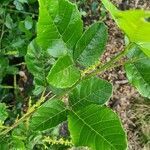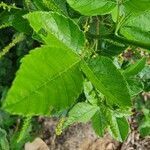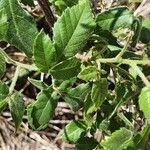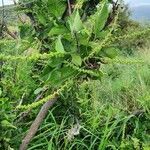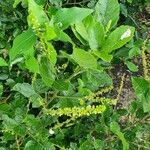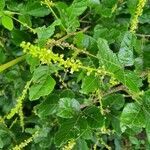Leaves 3-foliolate; petiole up to 5 cm. long, tomentose or densely pubescent; leaflets subequal or more often the terminal one up to twice as long as the lateral ones; petiolules up to 4 mm. long but leaflets usually subsessile; lamina of terminal leaflet 5–9 × 2·5–5 cm., obovate-elliptic or elliptic or rarely narrowly elliptic, usually broadest near the middle, papyraceous to chartaceous, densely pubescent to tomentose on both surfaces, minutely glandular beneath, usually with conspicuous tufts of hairs on the under surface in the axils of the lateral nerves and sometimes also in the axils of the secondary nerves, apex rounded to acute, margin irregularly crenate-serrate or dentate or remotely serrulate, base narrowly cuneate and distinctly narrowed from the middle downwards; lateral nerves 4–8 pairs.
A shrub. It grows about 5 m tall. The small branches are usually pale coloured. They can be hairy. The leaves have 3 leaflets. The leaf stalks is 5 cm long. The leaflet at the end is usually longer than the others. The end leaflet can be 5-9 cm long by 3-5 cm wide. They are narrowly oval. They are papery and hairy on both surfaces. The flowers are small and yellowish-green. The fruit is oval and fleshy. It turns orange-red to black when ripe.
Shrub (rarely shrublet) up to 5 m. tall or small tree; branchlets usually pale coloured, tomentose or densely pubescent and only tardily glabrescent.
Outer sepals 1·8 × 1·9 mm., subcircular, inner 1 × 1 mm., subcircular, all minutely pubescent or nearly glabrous, with minutely ciliate margins.
Flowers white, greenish-white or yellow, in few-flowered subsessile glomerules; pedicels up to 1·5 mm. long, sparsely pubescent or glabrous.
Stamens with filaments 1·6 mm. long., staminodes with filaments 0·6 mm. long in the male flowers.
Fruit red or orange, 4–6 mm. in diam., subglobose, sparsely pubescent.
Ovary 2-lobed, densely pubescent; style 2 mm. long, 2-fid.
Inflorescence 4–10 cm. long, branched or unbranched.
Petals 1·2–1·8 × 0·8–1 mm., clavate or spathulate.
